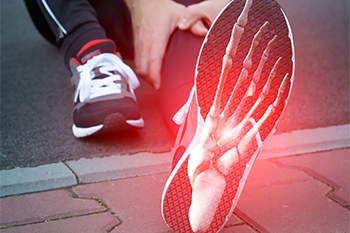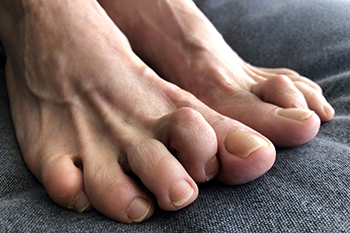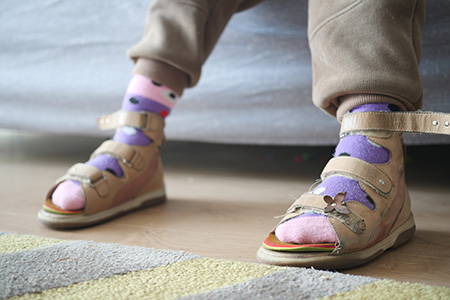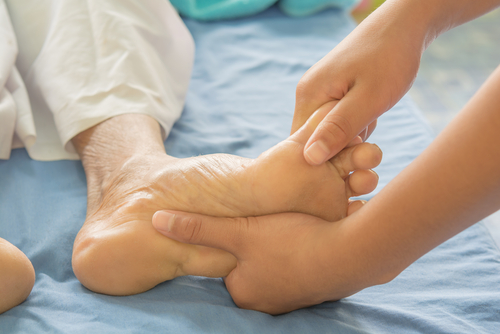Items filtered by date: December 2024
Causes of Foot Stress Fractures

Foot stress fractures occur when repeated stress or impact overwhelms the foot's bones, often from activities like running or jumping. A sudden increase in exercise intensity, duration, or frequency can place excessive strain on the bones, particularly if the body has not adjusted to the added workload. Changes in surface, such as moving from a soft running track to a hard sidewalk, may also trigger stress fractures. Wearing ill-fitting footwear that lacks proper support and cushioning can lead to uneven pressure distribution. Biomechanical issues, including bunions or improper gait, may force certain areas of the feet to bear more weight, which adds to the stress. Athletes, especially those involved in high-impact sports, are particularly vulnerable, but non-athletes engaging in prolonged walking or standing on hard or uneven surfaces can also develop stress fractures. A podiatrist can diagnose the injured foot using digital imaging and develop a treatment plan. If you experience foot pain after running, playing a sport or exercising, it is suggested that you schedule an appointment with a podiatrist to find out whether you may have developed stress fractures.
Activities where too much pressure is put on the feet can cause stress fractures. To learn more, contact Donovan Gowdie, DPM from The Foot & Ankle Treatment Center. Our doctor can provide the care you need to keep your pain free and on your feet.
Dealing with Stress Fractures of the Foot and Ankle
Stress fractures occur in the foot and ankle when muscles in these areas weaken from too much or too little use. The feet and ankles then lose support when walking or running from the impact of the ground. Since there is no protection, the bones receive the full impact of each step. Stress on the feet can cause cracks to form in the bones, thus creating stress fractures.
What Are Stress Fractures?
Stress fractures occur frequently in individuals whose daily activities cause great impact on the feet and ankles. Stress factors are most common among:
- Runners
- People affected with Osteoporosis
- Tennis or basketball players
- Gymnasts
- High impact workouts
Symptoms
Pain from the fractures occur in the area of the fractures and can be constant or intermittent. It will often cause sharp or dull pain with swelling and tenderness. Engaging in any kind of activity which involves high impact will aggravate pain.
If you have any questions please contact our office located in Watkinsville, GA . We offer the newest diagnostic and treatment technologies for all your foot and ankle needs.
Two Types of Hammertoes

Hammertoes are a common foot condition where one or more of the toes bend abnormally at the middle joint, causing them to resemble a hammer. There are two types of hammertoes, flexible and rigid. In flexible hammertoe, the joint is still movable but bends downward, causing pain when walking or wearing shoes. Over time, if left untreated, a flexible hammertoe can become rigid, where the joint becomes fixed in a bent position, making the condition more painful and difficult to treat. The primary causes of hammertoes include wearing ill-fitting shoes, genetics, and muscle imbalances that affect the alignment of the toes. High heels and wearing tight footwear can worsen the condition by crowding the toes and forcing them into unnatural positions. Visiting a podiatrist is key to a proper diagnosis and treatment. This type of doctor can recommend orthotics, exercises, or in severe cases, surgery to correct the deformity and relieve pain. If you have a hammertoe, it is suggested that you schedule an appointment with a podiatrist.
Hammertoe
Hammertoes can be a painful condition to live with. For more information, contact Donovan Gowdie, DPM from The Foot & Ankle Treatment Center. Our doctor will answer any of your foot- and ankle-related questions.
Hammertoe is a foot deformity that affects the joints of the second, third, fourth, or fifth toes of your feet. It is a painful foot condition in which these toes curl and arch up, which can often lead to pain when wearing footwear.
Symptoms
- Pain in the affected toes
- Development of corns or calluses due to friction
- Inflammation
- Redness
- Contracture of the toes
Causes
Genetics – People who are genetically predisposed to hammertoe are often more susceptible
Arthritis – Because arthritis affects the joints in your toes, further deformities stemming from arthritis can occur
Trauma – Direct trauma to the toes could potentially lead to hammertoe
Ill-fitting shoes – Undue pressure on the front of the toes from ill-fitting shoes can potentially lead to the development of hammertoe
Treatment
Orthotics – Custom made inserts can be used to help relieve pressure placed on the toes and therefore relieve some of the pain associated with it
Medications – Oral medications such as anti-inflammatories or NSAIDs could be used to treat the pain and inflammation hammertoes causes. Injections of corticosteroids are also sometimes used
Surgery – In more severe cases where the hammertoes have become more rigid, foot surgery is a potential option
If you have any questions, please feel free to contact our office located in Watkinsville, GA . We offer the newest diagnostic and treatment technologies for all your foot care needs.
Balance Exercises Can Help Prevent Falling

Balance exercises can play a vital role in maintaining stability and preventing falls, especially as people age. Poor balance often stems from weakened muscles in the feet, ankles, and toes, which are key areas for maintaining a steady gait. Declining strength can make daily activities like walking or standing more challenging, which increases the risk of falls. Regular balance exercises that target these areas, like heel raises or toe taps, can enhance muscle coordination and foot control. These exercises not only strengthen the lower body but also improve proprioception, or the body’s awareness of its position in space. A podiatrist can evaluate your feet and ankles for issues that may contribute to balance problems, such as deformities, joint instability, or conditions like arthritis. This foot doctor also can recommend specific strategies to improve foot and ankle strength and reduce your risk of falls. If you are exhibiting balance problems, it is suggested that you schedule an appointment with a podiatrist for an exam that may help to avoid falling.
Preventing falls among the elderly is very important. If you are older and have fallen or fear that you are prone to falling, consult with Donovan Gowdie, DPM from The Foot & Ankle Treatment Center. Our doctor will assess your condition and provide you with quality advice and care.
Every 11 seconds, an elderly American is being treated in an emergency room for a fall related injury. Falls are the leading cause of head and hip injuries for those 65 and older. Due to decreases in strength, balance, senses, and lack of awareness, elderly persons are very susceptible to falling. Thankfully, there are a number of things older persons can do to prevent falls.
How to Prevent Falls
Some effective methods that older persons can do to prevent falls include:
- Enrolling in strength and balance exercise program to increase balance and strength
- Periodically having your sight and hearing checked
- Discuss any medications you have with a doctor to see if it increases the risk of falling
- Clearing the house of falling hazards and installing devices like grab bars and railings
- Utilizing a walker or cane
- Wearing shoes that provide good support and cushioning
- Talking to family members about falling and increasing awareness
Falling can be a traumatic and embarrassing experience for elderly persons; this can make them less willing to leave the house, and less willing to talk to someone about their fears of falling. Doing such things, however, will increase the likelihood of tripping or losing one’s balance. Knowing the causes of falling and how to prevent them is the best way to mitigate the risk of serious injury.
If you have any questions, please feel free to contact our office located in Watkinsville, GA . We offer the newest diagnostic and treatment technologies for all your foot care needs.
Orthotic Use in Children With Blount’s Disease

Infantile Blount’s disease, also known as infantile tibia vara, is a growth disorder affecting the shinbone, or tibia, causing it to bow outward below the knee. This condition occurs when the inner part of the tibia fails to develop properly, often due to excessive pressure on the growth plate. It typically affects children under the age of three and is more common in those who are overweight, have early walking milestones, or have a family history of the condition. Orthotics play a vital role in managing infantile Blount’s disease. Custom-made braces or orthotic devices help guide proper bone growth and alignment, reducing the progression of bowing. By promoting proper leg alignment, these devices improve the child’s gait allowing them to walk more comfortably and efficiently while reducing long-term mobility issues. If your child was born with Blount’s disease, it is suggested that you see a podiatrist early on to discuss how orthotics can offer comfort, an improved gait, and better future development.
If you are having discomfort in your feet and would like to try orthotics, contact Donovan Gowdie, DPM from The Foot & Ankle Treatment Center. Our doctor can provide the care you need to keep you pain-free and on your feet.
What Are Orthotics?
Orthotics are inserts you can place into your shoes to help with a variety of foot problems such as flat feet or foot pain. Orthotics provide relief and comfort for minor foot and heel pain but can’t correct serious biomechanical problems in your feet.
Over-the-Counter Inserts
Orthotics come in a wide variety of over-the-counter inserts that are used to treat foot pain, heel pain, and minor problems. For example, arch supports can be inserted into your shoes to help correct overarched or flat feet, while gel insoles are often used because they provide comfort and relief from foot and heel pain by alleviating pressure.
Prescription Orthotics
If over-the-counter inserts don’t work for you or if you have a more severe foot concern, it is possible to have your podiatrist prescribe custom orthotics. These high-quality inserts are designed to treat problems such as abnormal motion, plantar fasciitis, and severe forms of heel pain. They can even be used to help patients suffering from diabetes by treating foot ulcers and painful calluses and are usually molded to your feet individually, which allows them to provide full support and comfort.
If you are experiencing minor to severe foot or heel pain, it’s recommended to speak with your podiatrist about the possibilities of using orthotics. A podiatrist can determine which type of orthotic is right for you and allow you to take the first steps towards being pain-free.
If you have any questions, please feel free to contact our office located in Watkinsville, GA . We offer the newest diagnostic and treatment technologies for all your foot care needs.
See Your Foot Specialist Regularly If You Work On Your Feet
How Aging Can Affect the Feet

As people age, the feet undergo changes that can lead to discomfort and mobility challenges. Years of wear and tear, in addition to conditions such as arthritis or diabetes, can cause pain, swelling, and stiffness. The natural thinning of the fat pads that cushion the feet may increase foot pain when walking and standing. Furthermore, reduced bone density, particularly seen in post-menopausal women, can increase the risk of stress fractures. Joint inflammation and nerve damage, often associated with aging, can also affect balance and increase the likelihood of falls. Poor circulation, common in older adults, can delay healing and make the feet more susceptible to injuries or infections. A podiatrist can assess the type of foot pain you have and recommend custom orthotics, certain medication to relieve pain, or ways to enhance mobility. If you are a senior suffering from foot pain, it is suggested that you schedule an appointment with a podiatrist for a diagnosis and treatment options.
Proper foot care is something many older adults forget to consider. If you have any concerns about your feet and ankles, contact Donovan Gowdie, DPM from The Foot & Ankle Treatment Center. Our doctor can provide the care you need to keep you pain-free and on your feet.
The Elderly and Their Feet
As we age we start to notice many changes in our body, but the elder population may not notice them right away. Medical conditions may prevent the elderly to take notice of their foot health right away. Poor vision is a lead contributor to not taking action for the elderly.
Common Conditions
- Neuropathy – can reduce feeling in the feet and can hide many life-threatening medical conditions.
- Reduced flexibility – prevents the ability of proper toenail trimming, and foot cleaning. If left untreated, it may lead to further medical issues.
- Foot sores – amongst the older population can be serious before they are discovered. Some of the problematic conditions they may face are:
- Gouging toenails affecting nearby toe
- Shoes that don’t fit properly
- Pressure sores
- Loss of circulation in legs & feet
- Edema & swelling of feet and ankles
Susceptible Infections
Diabetes and poor circulation can cause general loss of sensitivity over the years, turning a simple cut into a serious issue.
If you have any questions, please feel free to contact our office located in Watkinsville, GA . We offer the newest diagnostic and treatment technologies for all your foot care needs.

